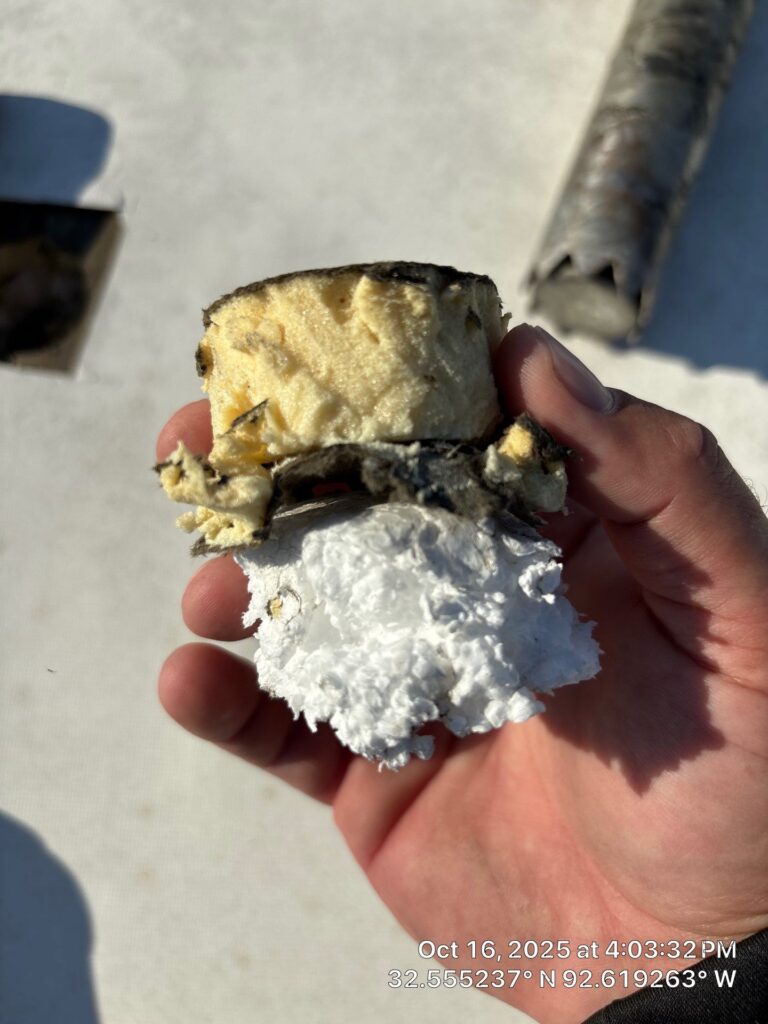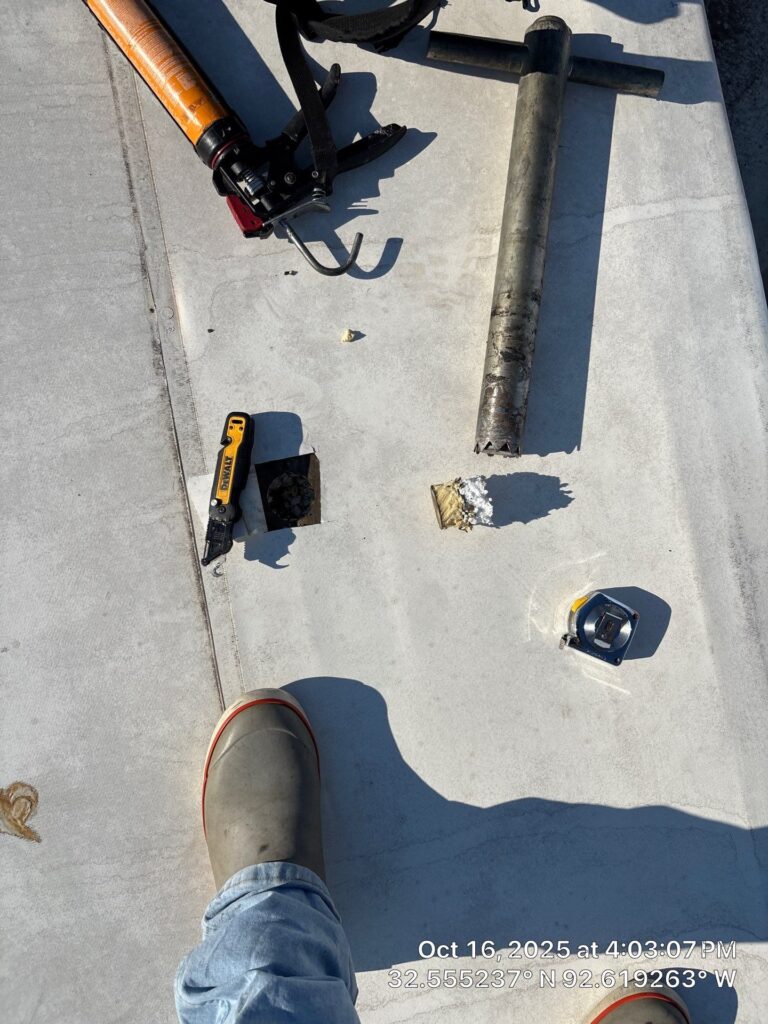When it comes to commercial roofing, understanding the existing roof system is critical for making informed decisions about repairs, overlays, or replacements. One of the most effective ways to gather this information is through a process called a core sample. This method, while considered “destructive testing,” is an essential step in ensuring the longevity and performance of a commercial roof. At Browns Roofing, we take pride in our meticulous approach to core sampling, ensuring that every roof we work on is evaluated with precision and care.
What is a Core Sample?
A core sample involves cutting into a commercial roof to extract a small section of the roofing system. This process allows roofing professionals to analyze the layers of the roof, including the number of existing roof systems, the thickness and condition of the insulation, and the type of deck beneath the roof. While it may seem counterintuitive to cut into a roof, this “destructive testing” is a necessary step to gather accurate data about the roof’s composition and condition.
Why is Core Sampling Important?
Core sampling serves two primary purposes in commercial roofing:
- Determining the Existing Roof Assembly
By analyzing the roof’s layers, we can determine whether the roof is a candidate for a recovery system or if a full replacement is necessary. Many manufacturers and No Dollar Limit (NDL) warranties only allow for a roof to be overlaid once. A core sample ensures that the roof meets these requirements before proceeding with an overlay. - Investigating Moisture Saturation
Moisture trapped within the roofing insulation can compromise the roof’s integrity and performance. Core sampling helps identify areas of moisture saturation, allowing us to remove the affected insulation and prevent further damage.

The Core Sampling Process at Browns Roofing
At Browns Roofing, we train our commercial account managers extensively to perform core samples with precision and care. Using specialized tools, our team carefully cuts into the roof to extract a sample without causing unnecessary damage. Here’s what we look for during the process:
- Number of Roof Layers: To ensure compliance with manufacturer warranties, we verify whether the roof has already been overlaid.
- Insulation Thickness and Condition: Insulation plays a critical role in energy efficiency and roof performance. We assess its thickness and check for signs of moisture or deterioration.
- Deck Type: Understanding the type of deck (metal, structural concrete, etc.) is essential for designing the appropriate roofing system.
Some commercial roofs can have up to 8 inches of material that needs to be removed down to the deck surface. This extensive removal process significantly impacts the cost of a roof replacement, making accurate core sampling even more critical for budgeting and planning.

Additional Testing Measures
While core sampling is a vital step, it is often complemented by other testing methods to ensure a comprehensive assessment of the roof’s condition:
- Thermal Scans: Thermal imaging helps identify anomalies, such as areas of trapped moisture or heat loss, that may not be visible to the naked eye. These scans guide our account managers to the right spots for core sampling.
- Field Assessments with a Tramex: A Tramex moisture meter is used to measure moisture levels in the roof before conducting core samples. This ensures that our testing is accurate and reliable.
The Role of No Dollar Limit Warranties
No Dollar Limit (NDL) warranties are a significant benefit for building owners, as they guarantee that the manufacturer will cover the full cost of repairs or replacements if the roofing system fails. However, these warranties come with strict requirements:
- The roofing system must be designed and installed according to the manufacturer’s specifications.
- The roof must pass a pull test, which measures the adhesion strength of the roof system to the deck.
At Browns Roofing, we ensure that every roof we work on meets these standards, providing our clients with peace of mind and long-term protection.
Documentation: A Core Value of Unwavering Honesty
One of Browns Roofing’s core values is unwavering honesty, and this principle is evident in our approach to core sampling. Before beginning any project, we ask building owners if they have previous core sample documentation. If no documentation is available, we provide detailed reports for future reference. This transparency ensures that all decisions are based on factual evidence, leaving no room for disputes.
Providing accurate documentation is not just a service—it’s a commitment to integrity. Once the results of a core sample are documented, the facts speak for themselves, allowing building owners to make informed decisions about their roofing systems.
The Importance of Dry Insulation
Roofing insulation must remain dry to maintain its performance and longevity. Moisture-saturated insulation not only compromises the roof’s energy efficiency but also disqualifies it from being overlaid in the future. By identifying and removing wet insulation during the core sampling process, we help building owners protect their roofing assets and extend the life of their roofs.
Overlay Options: A Cost-Effective Solution
At Browns Roofing, we understand the value of cost-effective solutions like roof overlays. However, we only recommend overlays if the testing confirms that the roof is a suitable candidate. This ensures compliance with manufacturer warranties and protects the building owner’s investment.
Conclusion
Core sampling is a critical step in the commercial roofing process, providing valuable insights into the roof’s condition and composition. At Browns Roofing, we combine industry expertise with cutting-edge technology to deliver accurate and reliable results. From core sampling to thermal scans and moisture assessments, our comprehensive approach ensures that every roof we work on is designed to perform at its best.
If you’re considering a roof overlay or replacement, trust Browns Roofing to provide the expertise and transparency you need. Contact us today to schedule a consultation and learn more about how we can help protect your commercial roofing investment.
